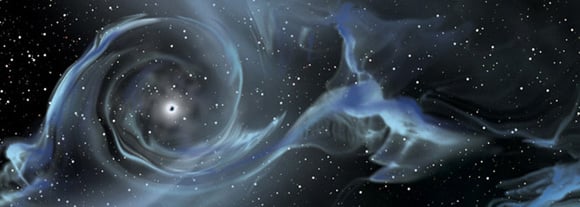Primordial black holes are remnants of the Big Bang and they are predicted to be knocking around in our universe right now. If they were 10
12
kg or bigger at the time of creation, they have enough mass to have survived constant evaporation from Hawking radiation over the 14 billion years since the beginning of the cosmos. But what happens when the tiny black hole evaporates so small that it becomes so tightly wrapped around the structure of a
fifth
dimension (other than the "normal" three spatial dimensions and one time dimension)? Well, the black hole will explosively show itself, much like an elastic band snapping, emitting energy. These final moments will signify that the primordial black hole has died. What makes this exciting is that researchers believe they can detect these events as spikes of radio wave emissions and the hunt has already begun...
Publications about primordial black holes have been very popular in recent years. There is the possibility that these ancient singularities are very common in the Universe, but as they are predicted to be quite small, their effect on local space isn't likely to be very observable (unlike younger,
super-massive black holes
at the centre of galaxies or the stellar black holes remaining after supernovae). However, they could be quite mischievous. Some primordial black hole antics include
kicking around asteroids
if they pass through the solar system,
blasting through the Earth
at high velocity, or even getting
stuck inside a planet
, slowly eating up material like a planetary parasite.
But say if these big bang relics never come near the Earth and we never see their effect on Earth (a relief, we can do without a primordial black hole playing billiards with near Earth asteroids or the threat of a mini black hole punching through the planet!)? How are we ever going to observe these theoretical singularities?
Now, the ultimate observatory has been realized, but it measures a fairly observable cosmic emission: radio waves.
The Eight-meter-wavelength Transient Array
(ETA) run by Virginia Tech Departments of Electrical & Computer Engineering and Physics, and the Pisgah Astronomical Research Institute (PARI), is currently taking high cadence radio wave observations and has been doing so for the past few months. This basic-looking antenna system, in fields in Montgomery County and North Carolina, could receive emissions in the 29-47 MHz frequencies, giving researchers a unique opportunity to see primordial black holes as they die.
Interestingly, if their predictions are correct, this could provide evidence for the existence of a fifth dimension, a dimension operating at scales of billionths of a nanometer. If this exotic emission can be received, and if it is corroborated by both antennae, this could be evidence of the string theory prediction that there are more dimensions than the four we currently understand.
" ." - Michael Kavic, project investigator.
As black holes are wrapped around this predicted fifth dimension, as they
slowly evaporate and lose mass
, eventually primordial black holes will be so stressed and stretched around the fifth dimension that the black hole will die, blasting out emissions in radio wave frequencies.
" ." - Kavic
When the
Large Hadron Collider
goes online in May, it is hoped that the high energies generated may produce mini-black holes (amongst other cool things) where research can be done to look for the string theory extra dimensions. But the Eight-meter-wavelength Transient Array looking for the death of "naturally occurring" primordial black holes is a far less costly endeavour and may achieve the same goal.
Here's an article on a theory that there could be
10 dimensions
.
Source:
Nature
 Universe Today
Universe Today
